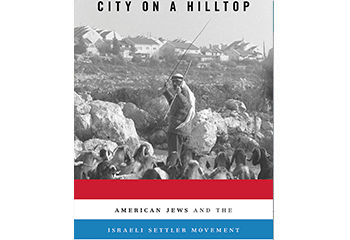Decades ago, the pundit Milton Himmelfarb quipped that Jews in the United States “earn like Episcopalians and vote like Puerto Ricans.” Although they were, on average, more prosperous than American gentiles, and although wealthier people tended to vote for more right-wing candidates, Jews were an exception, espousing liberal values and caring about the disadvantaged.
So the behaviour of American Jews who made aliyah in the years after 1967 is puzzling. Many continued to promote the liberal worldview in Israel. But as Sara Yael Hirschhorn demonstrates in her new book, City on a Hilltop, a high percentage of them became “settlers,” choosing to live beyond the Green Line, the borders of the State of Israel established in 1949. They settled in the Golan Heights, the West Bank of the Jordan and, for a time, in Gaza and the Sinai.
While acknowledging the difficulty of getting precise numbers, Hirschhorn relies on government statistics and studies conducted by other scholars, such as respected American-Israeli sociologist Chaim Waxman, to conclude that approximately 15 per cent of the Jews who live beyond the Green Line have U.S. citizenship, even though only around three per cent of Israeli Jews carry an American passport.
Hirschhorn asks: since settling beyond the Green Line is perceived as a right-wing activity, why are American Jews, who tend to be more liberal, so overrepresented among the settlers?
Her research centres on the first wave of Jews who made aliyah from the U.S. and came to three settlements: Yamit, Efrat and Tekoa – all places where the percentage of American immigrants was, or is, even higher than the 15 per cent mentioned above. Yamit, in the Sinai, was evacuated in 1982, after Israel made peace with Egypt. Efrat and Tekoa are located south of the Arab city of Bethlehem. (Some consider Efrat part of the so-called “consensus” – settlements that Israel would likely keep in a land swap, even if a Palestinian state were created.) The immigrants she studied were highly educated and did not leave the U.S. for economic reasons. Many made profound personal sacrifices when they made aliyah. Few were fundamentalists, or right-wing fanatics. In fact, many of the older ones had demonstrated against the Vietnam War.
Hirschhorn’s fascinating conclusion is that these settlers do not see themselves as having abandoned their liberal values. They claim that they put these values to work when they made aliyah and moved beyond the Green Line.
The American Jews who moved to Yamit envisioned themselves pursuing a “deeply American opportunity for new-age pioneering, building a utopian community and engaging in self-realization.”
The Jews who moved to Efrat, a planned suburb, had a different, but still very American, self-image. When the settlement began, it was promoted as “an English-speaking community with American suburban amenities and values.” (Today, half the residents are English speakers.) Efrat was largely an initiative of Rabbi Shlomo (Steve) Riskin, a charismatic modern Orthodox rabbi who moved from the West Side of Manhattan to what he jokingly calls “Central Park West Bank.”
READ: LEMONS SHOWS MIGRATION FROM POLAND, LIVES COMPLICATED BY OCEAN DRIVE
Rabbi Riskin, like many settlers, feels that the government of Israel has not done enough to support those living beyond the Green Line. (Yamit, Efrat and Tekoa were all grass-roots initiatives that the government agreed to, only after considerable lobbying.) The rabbi of another settlement, Rabbi Jonathan Blass, an American from a liberal background, says that, “We feel very much discriminated against.”
The late Rabbi Menachem Froman (who was not an American, but the rabbi of Tekoa, where 25 per cent of the residents are U.S. citizens) sincerely pursued peace and dialogue with Palestinians and saw no conflict in being a settler. “I thought we were making peace with the Arabs by living with them,” he once said.
Hirschhorn is generally nonjudgmental, but her own biases comes through in the final section of the book, where she goes into excessive detail about the tiny number of American Jews who have engaged in violence against Arabs. The name of Baruch Goldstein, an American immigrant who massacred 29 Muslim worshippers in the Cave of Machpelah in Hebron in 1994, appears in the book 39 times, including in the opening paragraph. Forms of the word “terror” appear 63 times. Shockingly, Hirschhorn applies the word twice as often to Jewish actions against Arabs, as to Arab actions against Jews.
As for Hirschhorn’s thesis, due to a shift to the right in recent years in the political outlook of American Jews, particularly Orthodox Jews, her findings might not apply to recent immigrants. But she strikes a chord when she says that her subjects, the early immigrants, combine “liberal values with an illiberal project.”
None of the American settlers that she interviewed believe that Palestinians living beyond the Green Line should be allowed to settle wherever they wish, or that the government of Israel should better protect Palestinians’ human rights. These settlers are generally sincere and idealistic people, who apparently do not notice that their self-presentation as defenders of human rights rings hollow when they promote only their own rights, and not those of their non-Jewish neighbours who outnumber them five to one.
